The Akron Pros were a professional football team that played in Akron, Ohio from 1908 to 1926. The team originated in 1908 as a semi-pro team named the Akron Indians, but later became Akron Pros in 1920 as the team set out to become a charter member of the American Professional Football Association. Fritz Pollard, the first black head coach in the NFL, co-coached the Akron Pros in 1921. Paul Robeson played for the team in 1921 as well. He was among the earliest stars of professional football before football became segregated from 1934 to 1946. In 1926, the name was changed back to the Akron Indians, after the earlier semi-pro team. Due to financial problems, the team suspended operations in 1927 and surrendered its franchise the following year.

The Rock Island Independents were a professional American football team, based in Rock Island, Illinois, from 1907 to 1926. The Independents were a founding National Football League franchise. They hosted what has been retrospectively designated the first National Football League game on September 26, 1920 at Douglas Park. The Independents were founded in 1907 by Demetrius Clements as an independent football club. Hence, the team was named the "Independents."

Henry Clifford "Doc" Carlson was an American basketball coach and football player. He is a Naismith Basketball Hall of Fame inductee as the men's college basketball coach of his alma mater, the University of Pittsburgh, from 1922 to 1953. At Pitt he compiled a record of 367–247 record (.595). His 1927–28 team finished the season with a 21–0 record and was retroactively named the national champion by the Helms Athletic Foundation and the Premo-Porretta Power Poll; Carlson's Panthers would receive retroactive recognition as the Helms national champion for the 1929–30 season as well. Carlson also led Pitt to the Final Four in 1941. As a student at the university, Carlson was also a First Team All-American end on Pitt's football team under coach "Pop" Warner. Carlson also lettered in basketball and baseball.

Charles W. "Charley" Bidwill Sr. was an American businessman. He was the owner of the Chicago Cardinals of the National Football League (NFL). He owned the team for 14 seasons, from 1933 through 1946. Bidwill was inducted into the Pro Football Hall of Fame in 1967.
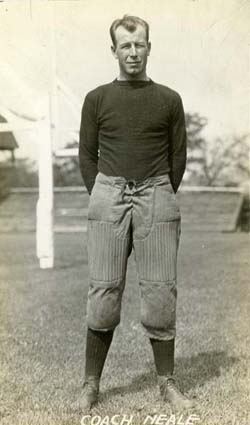
Alfred Earle "Greasy" Neale was an American football and baseball player and coach.
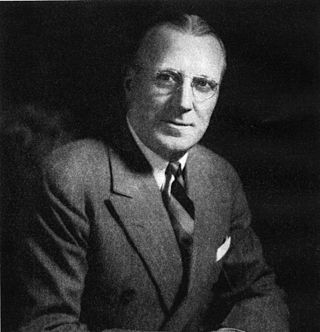
John Bain Sutherland was an American football player and coach. He coached college football at Lafayette College (1919–1923) and the University of Pittsburgh (1924–1938) and professional football for the Brooklyn Dodgers (1940–1941) and Pittsburgh Steelers (1946–1947). He was inducted into the College Football Hall of Fame in 1951.

Wilbur Francis "Pete" Henry was an American football player, coach, and athletic administrator. He was a charter inductee into both the College Football Hall of Fame in 1951 and the Pro Football Hall of Fame in 1963.
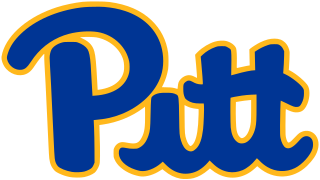
The Pittsburgh Panthers football program is the intercollegiate football team of the University of Pittsburgh, often referred to as "Pitt", in Pittsburgh, Pennsylvania. Traditionally the most popular sport at the university, Pitt football has played at the highest level of American college football competition, now termed the NCAA Division I Football Bowl Subdivision, since the beginning of the school's official sponsorship of the sport in 1890. Pitt competes as a member of the Atlantic Coast Conference (ACC).
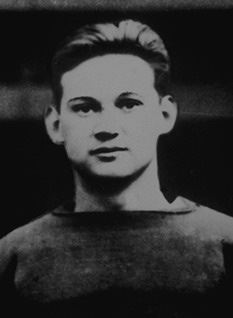
George W. "Tank" McLaren was an American football and basketball player and coach. Playing at the University of Pittsburgh under legendary football coach Pop Warner, McLaren was an All-American in 1917 and 1918. During his playing career, he was never stopped for a loss on a running play. McLaren served as head football coach at Emporia State University, then known as Kansas State Normal College, (1919), the University of Arkansas (1920–1921), the University of Cincinnati (1922–1926), and the University of Wyoming (1927–1929), compiling a career record of 32–55–8. He also coached basketball at Wyoming for two seasons (1928–1930), tallying a mark of 28–10. McLaren was inducted into the College Football Hall of Fame as a player in 1965.

Claude Earl "Tiny" Thornhill was an All-American college football player at Pittsburgh and the head football coach at Stanford from 1933 to 1939.
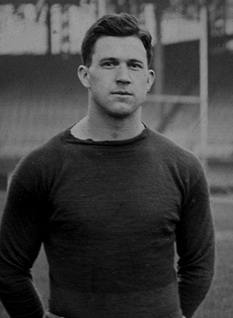
J. Huber "Hube" Wagner was an American football player who played college football at the University of Pittsburgh from 1910 until 1913 before becoming a prominent surgeon in Pittsburgh, Pennsylvania.
The Massillon Tigers were an early professional football team from Massillon, Ohio. Playing in the "Ohio League", the team was a rival to the pre-National Football League version of the Canton Bulldogs. The Tigers won Ohio League championships in 1903, 1904, 1905, and 1906, then merged to become "All-Massillons" to win another title in 1907. The team returned as the Tigers in 1915 but, with the reemergence of the Bulldogs, only won one more Ohio League title. Pro football was popularized in Ohio when the amateur Massillon Tigers hired four Pittsburgh pros to play in the season-ending game against Akron. At the same time, pro football declined in the Pittsburgh area, and the emphasis on the pro game moved west from Pennsylvania to Ohio.
Charles Elliott "Andy" Hastings, also known as "Sandy Hastings" in professional football records, was an American football player. He was an All-American halfback for the Pittsburgh Panthers and remains one of Pittsburgh's all-time leading scorers with 255 points.
The Pitcairn Quakers were a professional American football team from Pitcairn, Pennsylvania, United States. The team played as an independent from 1904 until 1920 and featured the best players in the community as well as some famous college-level players. A few of the players were college All-Americans. At one time, the team was loaded with Native Americans from nearby Carlisle Indian School. The team played many of the Midwestern teams that would later become future members of the National Football League.

George Melville "Doc" Flint was an American college basketball player and coach. He played at the University of Pennsylvania, where he was a two-time All-American, and served as the head basketball coach at the University of Pittsburgh's for ten seasons, from 1911 to 1921.
American football in Western Pennsylvania, featuring the city of Pittsburgh and surrounding areas, has had a long and storied history, dating back to the early days of the sport. All levels of football, including high school football and college football, are followed passionately, and the area's National Football League (NFL) team, the Pittsburgh Steelers, is consistently one of the sport's most popular teams. Many of the NFL's top stars have come from the region as well, especially those that play quarterback, earning Western Pennsylvania the nickname "Cradle of Quarterbacks".

The 1916 Pittsburgh Panthers football team was an American football team represented the University of Pittsburgh as an independent during the 1916 college football season. Led by coach Pop Warner, the Panthers won all eight games and outscored their opponents by a total of 255 to 25. The team was retroactively selected as the national champion by multiple NCAA-designated major selectors, including the Billingsley Report, Helms Athletic Foundation, Houlgate System, and National Championship Foundation, and by others as a co-national champion with Army by Parke H. Davis.
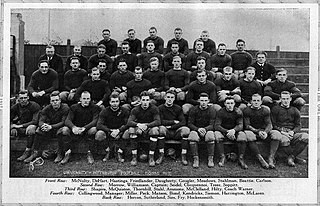
The 1915 Pittsburgh Panthers football team represented the University of Pittsburgh in the 1915 college football season. In his first season with the program, head coach Pop Warner led the Panthers to wins in all eight games and they outscored their opponents by a combined total of 247–19. Home games were held at Forbes Field, the ballpark of baseball's Pittsburgh Pirates.
The Canton Bulldogs were a professional American football team, based in Canton, Ohio. They played in the Ohio League from 1903 to 1906 and 1911 to 1919, and the American Professional Football Association, from 1920 to 1923, and again from 1925 to 1926. The Bulldogs won the 1916, 1917, and 1919 Ohio League championships. They were the NFL champions in 1922 and 1923. In 1921–1923, the Bulldogs played 25 straight games without a defeat. This remains an NFL record.












